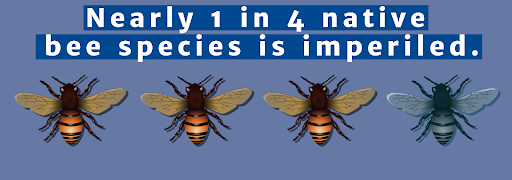

Friend,
What's killing our bees?
Scientists point to several causes, including climate change and habitat loss. But one major threat is the use of bee-killing pesticides, called neonicotinoids (or neonics).
Here's how they work:
To make agricultural crops more resistant to potentially harmful insects, many seeds are sold pre-treated -- or dipped in neonics -- which become systemic in the plant as it grows. In other cases, neonics are sprayed onto the foliage of mature plants or applied directly to nearby soil.1
These harmful pesticides -- absorbed through tainted plant pollen and nectar from flowering crops -- can cause paralysis and death in bees. Neonics also interfere with bees' ability to sleep, find food and navigate their way back to the hive.2,3
Even for those lucky ones that do manage to make it home, the danger isn't over.
After foraging through flowers contaminated with pesticides, bees return to their offspring with a toxic prize -- neonic-laced nectar. Targeting their nervous systems, neonics can cause permanent and irreversible brain damage to baby bees -- leading them to grow up with similar navigation problems as their parents or difficulty reproducing.4,5
Scientists recently determined that bees which came into contact with certain neonics produced nearly 20% fewer offspring -- leading to infertility across multiple generations.6
This all adds up to one big problem:
Bee-killing pesticides are a major factor in why bee populations are collapsing.
Over the last year, U.S. beekeepers lost nearly half of their managed honeybee colonies -- the second-highest loss rate ever recorded.7
And it's not just honeybees that are in trouble -- nearly 1 in 4 native bee species is imperiled.8

For the past two decades, scientists have witnessed alarming bee die-offs -- die-offs felt sharply by the western bumblebee, whose population has dropped by as much as 93% in the last 20 years.9
And in 2017, the rusty patched bumblebee became the first bee in the continental United States to be listed as an endangered species.10
Both honeybees and native bees play a vital role in our environment and our food supply -- losing them would have a devastating ripple effect across ecosystems. We can't let these precious pollinators slip away.
Ending the use of bee-killing pesticides isn't going to be easy, but with your help, here's how we're going to win:
- By convincing Amazon -- the world's largest online retailer -- to stop selling neonics, just like we helped convince Lowe's and Home Depot to commit to taking these toxic pesticides off their shelves. And to build support, we're going door to door across our country to ask the public to join our campaign.
- Calling on states across the country to ban the worst uses of neonics. Earlier this year, our sister group Environment Maine successfully led the charge to pass our nation's strongest bee protections.
- Expanding habitats for bees. We've already made progress on this, winning expanded pollinator protections on Department of Defense-owned land, and securing funding for habitat along highways in the infrastructure bill passed earlier this fall.
- Urging the Biden administration to ban the use of neonics in wildlife refuges, the places where bees should be safest, and asking the Environmental Protection Agency to ban the worst uses of these toxic pesticides nationwide.
Bees don't stand a chance if toxic pesticides continue interfering with their abilities to navigate, forage and reproduce. But thankfully, bees have you to defend them, Friend.
Thank you,
Rex Wilmouth
Senior Program Director
P.S. We're working to save the bees by banning the worst uses of pesticides that are killing them, and we've set a goal of raising $200,000 by Dec. 31 to keep our campaigns going strong in 2022. Donate to our Year-End Drive today.
1. "Pollinator Network at Cornell," Cornell College of Agriculture and Life Sciences, Last accessed December 2, 2021.
2. Stephen Leahy, "Insect 'Apocalypse' in U.S. Driven by 50x Increase in Toxic Pesticides," National Geographic, August 6, 2019.
3. Amy Woodyatt, "Bees aren't getting enough sleep, thanks to some common pesticides," CNN, January 21, 2021.
4. Katie Hunt, "Pesticides damage the brains of baby bees, new research finds," CNN, March 3, 2020.
5. Douglas Maine, "Insecticides can reduce bee fertility, causing lasting harm across generations," National Geographic, November 22, 2021.
6. Douglas Maine, "Insecticides can reduce bee fertility, causing lasting harm across generations," National Geographic, November 22, 2021.
7. University of Maryland, "US beekeepers continue to report high colony loss rates, no clear improvement," Science News, June 23, 2021.
8. Maryellen Kennedy Duckett, "Nature needs us to act," National Geographic, March 4, 2020.
9. Amy Joi O'Donoghue, "Dramatic decline found in Western bumblebee populations," The Denver Post, June 25, 2020.
10. "Rusty Patched Bumble Bee," U.S. Fish and Wildlife Service, May 29, 2019.
Your donation will be used to support all of our campaigns to protect the environment, from saving the bees and protecting public lands, to standing up for clean water and fighting climate change. None of our work would be possible without supporters like you. Environment Colorado may transfer up to $50 per dues-paying member per year into the Environment Colorado Small Donor Committee.
Environment Colorado, Inc.
1543 Wazee St., Suite 400, Denver, CO 80202, (303) 573-3871
Member questions or requests call 1-800-401-6511.
Facebook | Twitter
If you want us to stop sending you e-mail then follow this link -- Unsubscribe